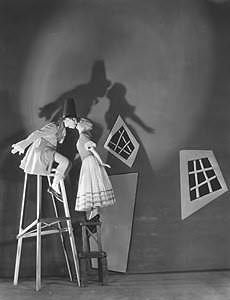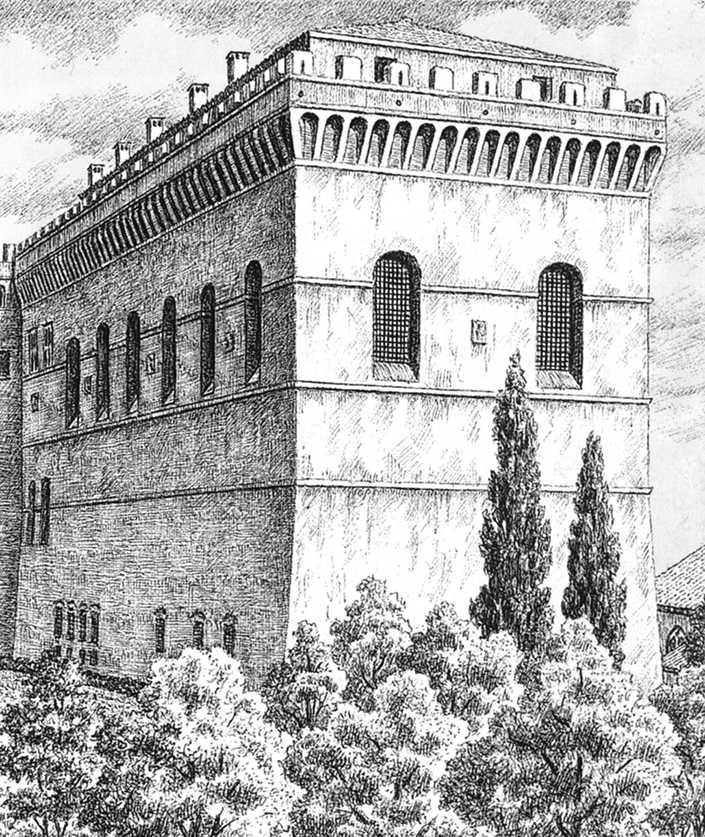|
Aubette (building)
L’Aubette is an historical building on Place Kléber in Strasbourg, France. It was built by Jacques-François Blondel in 1765–1772. In 1926, three avant-garde artists Theo van Doesburg, Sophie Taeuber-Arp and Jean Arp (or Hans Arp) were commissioned by Paul and Adré Horn to redecorate and design the Café Aubette in Strasbourg. Three artists were equally responsible for different sections of the building. Theo van Doesburg was in charge of the two cafés and two dance halls, Sophie Taeuber for the entrance aisle, tearoom, and two bars, and Jean Arp for the basement, the passage, and billiard room. And all three artists worked together designing the stairwell. The work of the three artists had been called "the Sistine Chapel of abstract art". This historical building still opens as a historical landmark nowadays. History before 1920 L'Aubette originated from a monastic complex in the thirteenth century. Most of the construction collapsed in the sixteenth century and ... [...More Info...] [...Related Items...] OR: [Wikipedia] [Google] [Baidu] |
Aubette 1
{{Disambiguation ...
Aubette may refer to: * Aubette (building) French rivers: * Aubette (Seine-Maritime) * Aubette de Meulan * Aubette de Magny * Aubette (Aube) The Aubette is a 20 km long river of France (Côte-d'Or and Haute-Marne Haute-Marne (; English: Upper Marne) is a department in the Grand Est region of Northeastern France. Named after the river Marne, its prefecture is Chaumont. In 2019, ... [...More Info...] [...Related Items...] OR: [Wikipedia] [Google] [Baidu] |
Place Kléber
The Place Kléber (''Kleberplatz'' in German) is the central square of Strasbourg, France. Place Kleber, the largest square at the center of the city of Strasbourg in the heart of the city's commercial area, was named after French revolutionary general Jean-Baptiste Kléber, born in Strasbourg in 1753. In the square is a statue of Kléber, under which is a vault containing his remains. On the north side of the square is the Aubette (Orderly Room), built by Blondel in 1765-1772. Located in Strasbourg's historic center (the '' Grande Île'' ("Large Island")) the area was classified a World Heritage Site by UNESCO in 1988, the first time such an honor was placed on an entire city center. History The first name of Place Kléber was ('square of the barefoot nuns' in German: square of the bare-feet-goers because a Franciscan monastery was standing along the square). In the 17th century the name changed to ('arms square' in German). On 24 June 1840 the square was finally re ... [...More Info...] [...Related Items...] OR: [Wikipedia] [Google] [Baidu] |
Strasbourg
Strasbourg (, , ; german: Straßburg ; gsw, label=Bas Rhin Bas-Rhin (; Alsatian: ''Unterelsàss'', ' or '; traditional german: links=no, Niederrhein; en, Lower Rhine) is a department in Alsace which is a part of the Grand Est super-region of France. The name means 'Lower Rhine', referring to its lowe ... Alsatian dialect, Alsatian, Strossburi , gsw, label=Haut Rhin Alsatian dialect, Alsatian, Strossburig ) is the Prefectures in France, prefecture and largest city of the Grand Est Regions of France, region of Geography of France, eastern France and the Seat of the European Parliament in Strasbourg, official seat of the European Parliament. Located at the France–Germany border, border with Germany in the historic region of Alsace, it is the prefecture of the Bas-Rhin Departments of France, department. In 2019, the city proper had 287,228 inhabitants and both the Eurométropole de Strasbourg (Greater Strasbourg) and the Arrondissement of Strasbourg had 505,272 inhabita ... [...More Info...] [...Related Items...] OR: [Wikipedia] [Google] [Baidu] |
France
France (), officially the French Republic ( ), is a country primarily located in Western Europe. It also comprises of overseas regions and territories in the Americas and the Atlantic, Pacific and Indian Oceans. Its metropolitan area extends from the Rhine to the Atlantic Ocean and from the Mediterranean Sea to the English Channel and the North Sea; overseas territories include French Guiana in South America, Saint Pierre and Miquelon in the North Atlantic, the French West Indies, and many islands in Oceania and the Indian Ocean. Due to its several coastal territories, France has the largest exclusive economic zone in the world. France borders Belgium, Luxembourg, Germany, Switzerland, Monaco, Italy, Andorra, and Spain in continental Europe, as well as the Netherlands, Suriname, and Brazil in the Americas via its overseas territories in French Guiana and Saint Martin. Its eighteen integral regions (five of which are overseas) span a combined area of ... [...More Info...] [...Related Items...] OR: [Wikipedia] [Google] [Baidu] |
Jacques-François Blondel
Jacques-François Blondel (8 January 1705 – 9 January 1774) was an 18th-century French architect and teacher. After running his own highly successful school of architecture for many years, he was appointed Professor of Architecture at the Académie Royale d'Architecture in 1762, and his ''Cours d'architecture'' ("Course of Architecture", 1771–1777) largely superseded a similarly titled book published in 1675 by his famous namesake, François Blondel, who had occupied the same post in the late 17th century. Career Born in Rouen, he initially trained under his uncle Jean-François Blondel (1683–1756), architect of Rouen. Jacques-François was in Paris by 1726 and continued his studies with Gilles-Marie Oppenord, from whom he acquired a knowledge of rococo. He also worked with Jean Mariette, contributing to the latter's ''L'Architecture françoise'' (1727, 1738), as a writer and as an architectural engraver. Blondel developed into a conservative and thorough architect, who ... [...More Info...] [...Related Items...] OR: [Wikipedia] [Google] [Baidu] |
Avant-garde
The avant-garde (; In 'advance guard' or ' vanguard', literally 'fore-guard') is a person or work that is experimental, radical, or unorthodox with respect to art, culture, or society.John Picchione, The New Avant-garde in Italy: Theoretical Debate and Poetic Practices' (Toronto: University of Toronto Press, 2004), p. 64 . It is frequently characterized by aesthetic innovation and initial unacceptability.Kostelanetz, Richard, ''A Dictionary of the Avant-Gardes'', Routledge, May 13, 2013 The avant-garde pushes the boundaries of what is accepted as the norm or the '' |
Theo Van Doesburg
Theo van Doesburg (, 30 August 1883 – 7 March 1931) was a Dutch artist, who practiced painting, writing, poetry and architecture. He is best known as the founder and leader of De Stijl. He was married to artist, pianist and choreographer Nelly van Doesburg. Early life Theo van Doesburg was born Christian Emil Marie Küpper on 30 August 1883, in Utrecht, Netherlands, as the son of the photographer and Henrietta Catherina Margadant. After a short period of training in acting and singing, he decided to become a storekeeper. He always regarded his stepfather, Theodorus Doesburg, to be his natural father, so that his first works are signed with Theo Doesburg, to which he later added "van". Career His first exhibition was in 1908. From 1912 onwards, he supported his works by writing for magazines. He considered himself to be a modern painter, at that time, although his early work is in line with the Amsterdam Impressionists and is influenced by Vincent van Gogh, both in sty ... [...More Info...] [...Related Items...] OR: [Wikipedia] [Google] [Baidu] |
Sophie Taeuber-Arp
Sophie Henriette Gertrud Taeuber-Arp (; 19 January 1889 – 13 January 1943) was a Swiss artist, painter, sculptor, textile designer, furniture and interior designer, architect, and dancer. Born in 1889 in Davos, and raised in Trogen, Switzerland, she attended a trade school in St. Gallen and, later, art schools in Germany, before moving back to Switzerland during the First World War. At an exhibition in 1915, she met for the first time the German-French artist Hans/Jean Arp, whom she married shortly after. It was during these years that they became associated with the Dada movement, which emerged in 1916, and Taeuber-Arp's most famous works – ''Dada Head'' (''Tête Dada''; 1920) – date from these years. They moved to France in 1926, where they stayed until the invasion of France during the Second World War, at the event of which they went back to Switzerland. In 1943, she died in an accident with a leaking gas stove. Despite being overlooked since her death, she is conside ... [...More Info...] [...Related Items...] OR: [Wikipedia] [Google] [Baidu] |
Jean Arp
Hans Peter Wilhelm Arp (16 September 1886 – 7 June 1966), better known as Jean Arp in English, was a German-French sculptor, painter, and poet. He was known as a Dadaist and an abstract artist. Early life Arp was born in Straßburg (now Strasbourg), the son of a French mother and a German father, during the period following the Franco-Prussian War when the area was known as Alsace-Lorraine (''Elsass-Lothringen'' in German) after France had ceded it to Germany in 1871. Following the return of Alsace to France at the end of World War I, French law determined that his name become "Jean". Arp would continue referring to himself as "Hans" when he spoke German. Career Dada In 1904, after leaving the École des Arts et Métiers in Straßburg, he went to Paris where he published his poetry for the first time. From 1905 to 1907, he studied at Kunstschule in Weimar, Germany, and in 1908 went back to Paris, where he attended the Académie Julian. Arp was a founder-member of the ... [...More Info...] [...Related Items...] OR: [Wikipedia] [Google] [Baidu] |
Sistine Chapel
The Sistine Chapel (; la, Sacellum Sixtinum; it, Cappella Sistina ) is a chapel in the Apostolic Palace, the official residence of the pope in Vatican City. Originally known as the ''Cappella Magna'' ('Great Chapel'), the chapel takes its name from Pope Sixtus IV, who had it built between 1473 and 1481. Since that time, the chapel has served as a place of both religious and functionary papal activity. Today, it is the site of the papal conclave, the process by which a new pope is selected. The fame of the Sistine Chapel lies mainly in the frescoes that decorate the interior, most particularly the Sistine Chapel ceiling and ''The Last Judgment'', both by Michelangelo. During the reign of Sixtus IV, a team of Renaissance painters that included Sandro Botticelli, Pietro Perugino, Pinturicchio, Domenico Ghirlandaio and Cosimo Rosselli, created a series of frescos depicting the ''Life of Moses'' and the ''Life of Christ'', offset by papal portraits above and '' trompe-l' ... [...More Info...] [...Related Items...] OR: [Wikipedia] [Google] [Baidu] |



.jpg)


